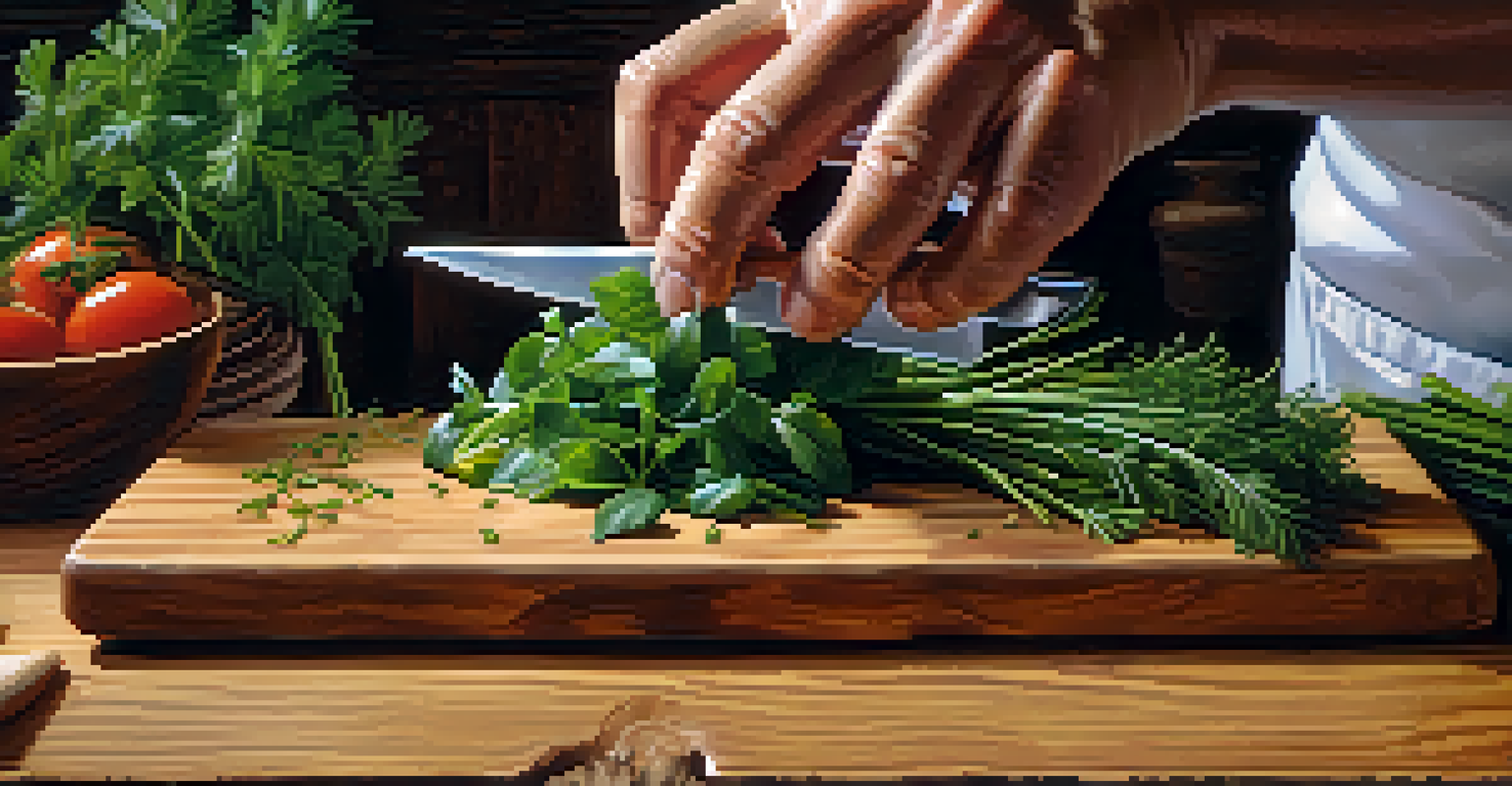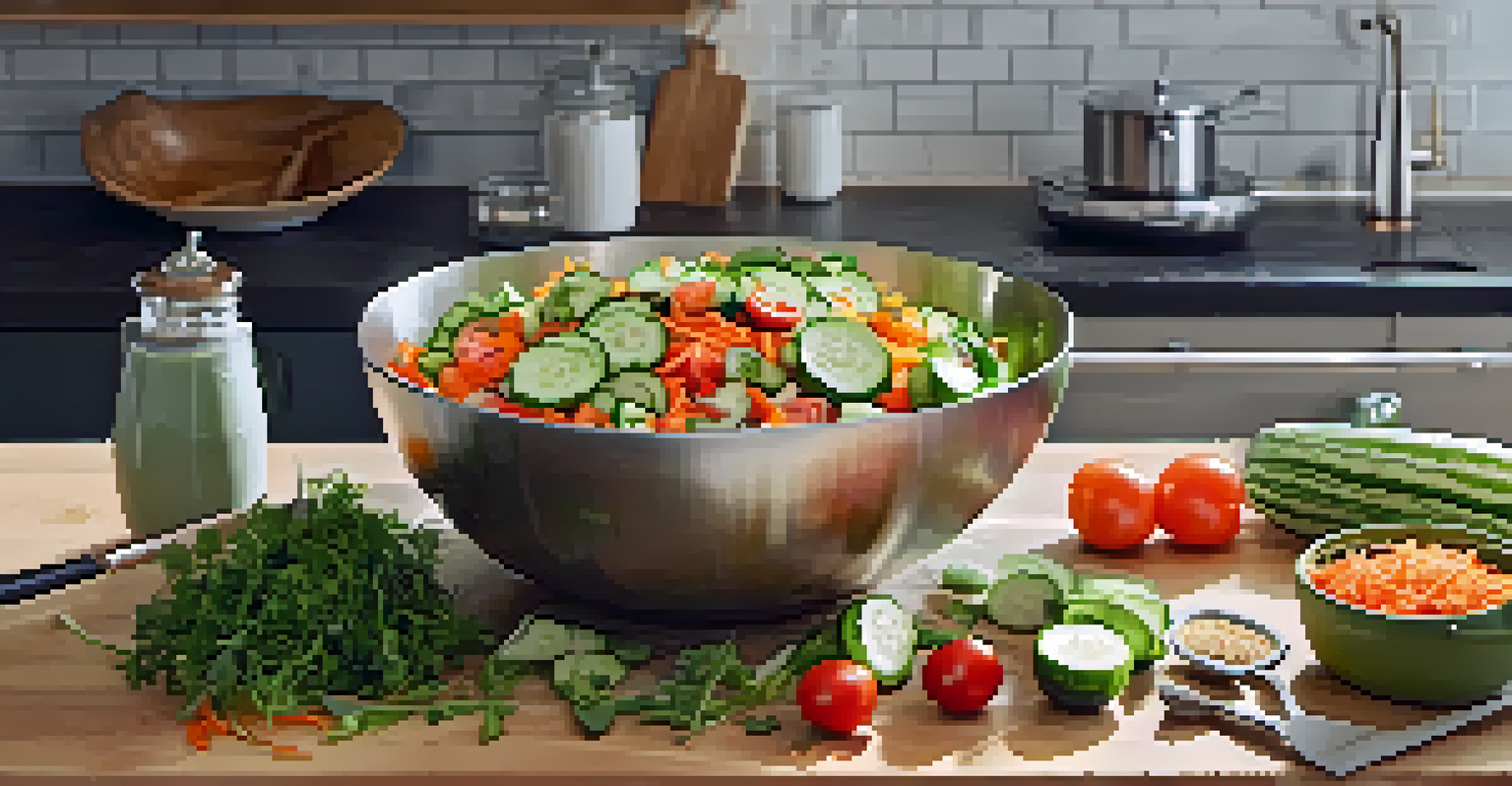Simple Techniques for Chopping and Preparing Raw Produce

Choosing the Right Tools for Your Kitchen Prep
When it comes to chopping raw produce, having the right tools is essential. A sharp chef's knife is often your best friend, making clean cuts and reducing the risk of injury. Additionally, a cutting board that's sturdy and the right size can make a world of difference in your prep time.
The only thing that can make a great meal is a great cook—and a great cook knows how to prep properly.
Don’t forget to include a peeler for fruits and vegetables with tough skins, like carrots or apples. A good pair of kitchen shears can also come in handy for snipping herbs or trimming leafy greens. Investing in quality tools not only speeds up the process but also enhances your overall experience in the kitchen.
Lastly, keep your tools clean and well-maintained. Regularly honing your knife and washing your cutting board will prevent cross-contamination and keep your food safe. Remember, a well-prepped kitchen is the first step to a successful meal!
Mastering Basic Knife Skills for Efficient Chopping
Knife skills may seem intimidating at first, but they’re easier to master than you think. Start with the 'claw grip' technique, where you curl your fingers under to hold the produce safely. This not only protects your fingers but also gives you better control as you chop.

Practice the 'rocking motion' by keeping the tip of the knife on the cutting board while moving the blade up and down. This method is particularly effective for chopping herbs or finely dicing vegetables. With a little practice, you’ll find yourself chopping like a pro in no time!
Essential Tools for Kitchen Prep
Having quality tools like a sharp knife and a sturdy cutting board can significantly improve your kitchen prep experience.
As you gain confidence, experiment with different cuts such as julienne, dice, and chiffonade. Each technique serves a purpose, whether for cooking or presentation. Remember, it’s all about practice; the more you chop, the better you’ll get!
Preparing Fruits: Peeling, Pitting, and Slicing
Fruits often require different techniques than vegetables, so knowing how to handle them is key. Start by washing your fruits thoroughly to remove any dirt or pesticides. Then, use a peeler to remove the skin of fruits like peaches or kiwis, making them more enjoyable to eat.
Waste not, want not.
For fruits with pits, like cherries or avocados, a simple pitting tool can save you a lot of hassle. Just make sure to be gentle to avoid damaging the fruit. Once pitted, slice them into manageable pieces for salads or snacks.
Don’t discard the peels without a second thought! Many peels, like apple or citrus, can be used in recipes or as garnishes. It’s a great way to minimize waste and add extra flavor to your dishes.
Vegetable Prep: Chopping, Dicing, and Mincing
Vegetables often require various chopping techniques depending on the dish you’re preparing. For salads or stir-fries, cutting vegetables into uniform pieces ensures even cooking and a pleasing presentation. Start by slicing larger veggies like bell peppers or zucchinis into strips before dicing them into bite-sized pieces.
Mincing is particularly useful for aromatic vegetables like garlic and onions. A fine mince releases more flavor, making your dishes more vibrant. Remember to use the flat side of the knife to crush garlic cloves before mincing, as this makes the process much simpler.
Master Your Knife Skills
Developing basic knife skills, such as the claw grip and rocking motion, can enhance your chopping efficiency and confidence.
Don’t shy away from experimenting with different shapes and sizes! Spiralizing zucchini or cutting carrots into sticks can add a fun twist to your meals. The key is to find a method that works for you and your recipe.
Storing Prepped Produce to Maintain Freshness
Once you've prepped your fruits and vegetables, storing them correctly is vital for keeping them fresh. Use airtight containers to minimize exposure to air and moisture. For leafy greens, a damp paper towel in the container can help maintain their crispness.
Labeling your containers with dates can also help you keep track of freshness. Try to use prepped produce within a few days to enjoy the best flavor and nutrients. Remember, the sooner you eat them, the more vibrant and delicious they will be!
For longer storage, consider blanching vegetables before freezing. This technique helps preserve color, flavor, and nutrients, making them perfect for future meals. With a little planning, you can always have fresh produce at your fingertips!
Using Produce Scraps: Tips for Zero-Waste Cooking
In the spirit of reducing waste, consider how you can use produce scraps in your cooking. Vegetable peels, stems, and leaves can be transformed into flavorful stocks or broths. Simply collect them in a freezer bag and boil them down for a delicious base for soups.
Herb stems, which are often discarded, can add depth to sauces and dressings. Chopping them finely can enhance the flavor profile of your dishes without extra cost. It’s a win-win situation for both your wallet and the environment!
Maximize Freshness and Minimize Waste
Properly storing prepped produce and utilizing scraps not only keeps your food fresh but also promotes zero-waste cooking.
Additionally, some scraps can be regrown, such as green onion roots or celery stubs. Place them in water, and with a bit of patience, you’ll have a fresh supply right from your kitchen. Embracing zero-waste cooking not only helps the planet but also sparks creativity in your meals!
Incorporating Seasonal Produce into Your Meals
One of the best ways to enjoy fresh produce is by incorporating seasonal fruits and vegetables into your meals. Seasonal produce tends to be more flavorful and affordable, making it a win-win for your palate and your budget. Pay attention to local farmers' markets for inspiration on what’s in season.
Experimenting with seasonal ingredients can also lead to new and exciting dishes. For example, summer brings an abundance of tomatoes and cucumbers, perfect for refreshing salads. In the fall, root vegetables like squash and carrots can be roasted for cozy comfort food.

Keeping your meals aligned with the seasons not only enhances taste but also supports local agriculture. Plus, it’s a wonderful way to introduce variety into your diet and explore new recipes throughout the year.